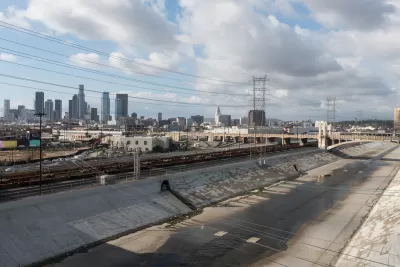Since the dissolution of California's redevelopment agencies, the state has been fine-tuning a new and improved economic development tool: Enhanced Infrastructure Financing Districts.

Like redevelopment agencies, Enhanced Infrastructure Financing Districts (EIFDs) capture tax increment. But unlike the CRA, they only get contributions from agencies that agree to join up and create an infrastructure-financing plan. In other words: They have to cooperate.
To expert Larry Kosmont, this design marks a shift in California toward a new model of economic development. He tells The Planning Report:
The shift is to an “Economic Development 2.0” model, which is about sustainability, infrastructure, resource management, and interagency cooperation, as opposed to sales tax, retail, and a “one outfit does it all” mentality.
Lawmakers also gave EIFDs new flexibility to combine a variety of funding sources. That opens the door to pursuing multiple benefits; for instance, an EIFD could be eligible for funds from California's cap-and-trade auctions—provided the projects outlined in its plan fulfilled state sustainability goals.
For now, Kosmont notes, early adopters of the EIFD structure tend to be in suburban communities, where often, fewer entities can work together to cover more area. But he predicts the tool will evolve to urban infill, for which it was arguably intended. Already, Los Angeles has considered creating one around the LA River.
FULL STORY: Kosmont: EIFDs Are A New Local ‘Economic Development 2.0' Tool

Planetizen Federal Action Tracker
A weekly monitor of how Trump’s orders and actions are impacting planners and planning in America.

Map: Where Senate Republicans Want to Sell Your Public Lands
For public land advocates, the Senate Republicans’ proposal to sell millions of acres of public land in the West is “the biggest fight of their careers.”

Restaurant Patios Were a Pandemic Win — Why Were They so Hard to Keep?
Social distancing requirements and changes in travel patterns prompted cities to pilot new uses for street and sidewalk space. Then it got complicated.

Platform Pilsner: Vancouver Transit Agency Releases... a Beer?
TransLink will receive a portion of every sale of the four-pack.

Toronto Weighs Cheaper Transit, Parking Hikes for Major Events
Special event rates would take effect during large festivals, sports games and concerts to ‘discourage driving, manage congestion and free up space for transit.”

Berlin to Consider Car-Free Zone Larger Than Manhattan
The area bound by the 22-mile Ringbahn would still allow 12 uses of a private automobile per year per person, and several other exemptions.
Urban Design for Planners 1: Software Tools
This six-course series explores essential urban design concepts using open source software and equips planners with the tools they need to participate fully in the urban design process.
Planning for Universal Design
Learn the tools for implementing Universal Design in planning regulations.
Heyer Gruel & Associates PA
JM Goldson LLC
Custer County Colorado
City of Camden Redevelopment Agency
City of Astoria
Transportation Research & Education Center (TREC) at Portland State University
Camden Redevelopment Agency
City of Claremont
Municipality of Princeton (NJ)


























